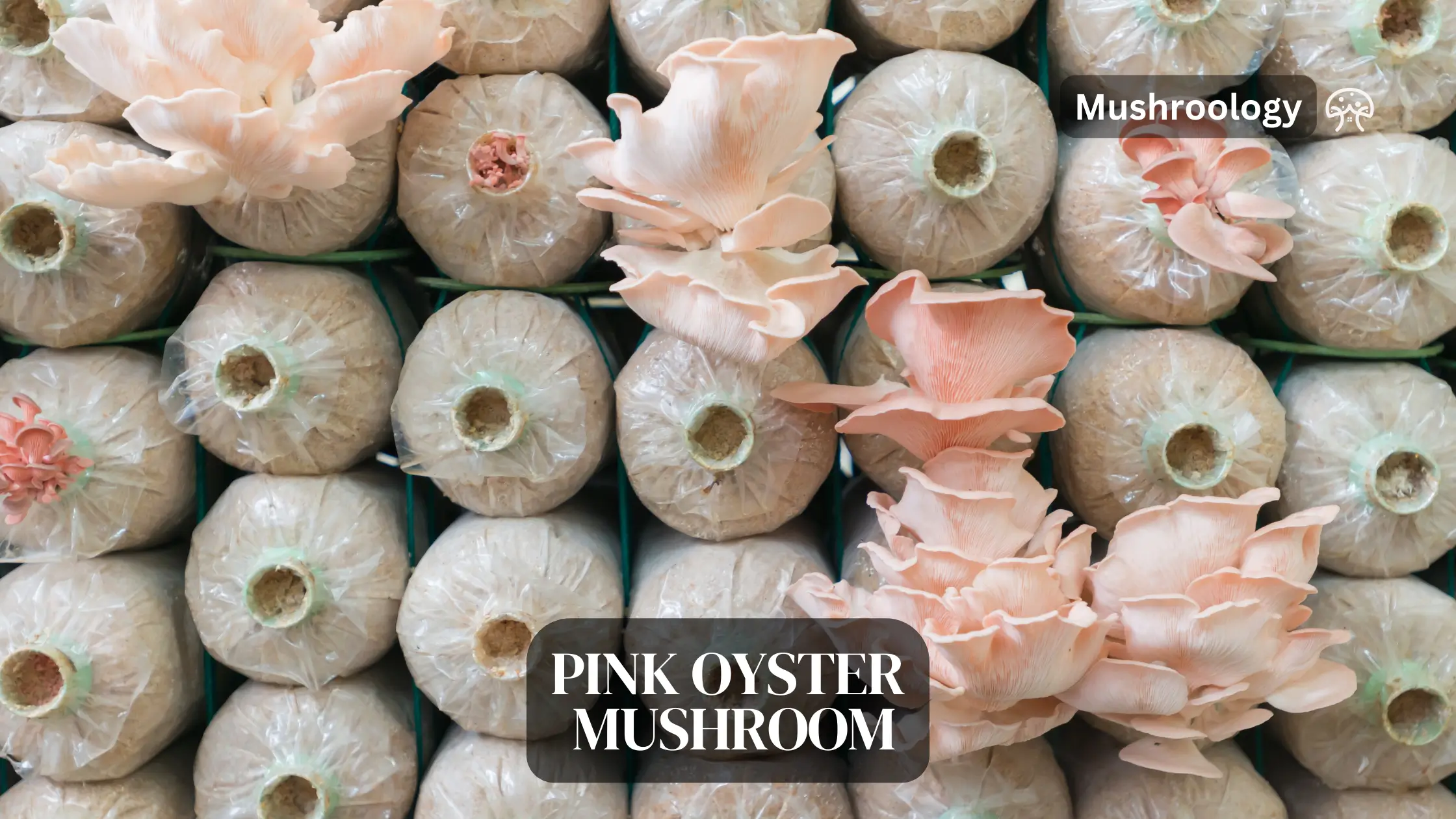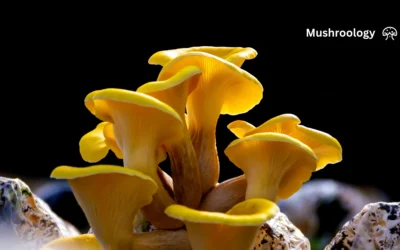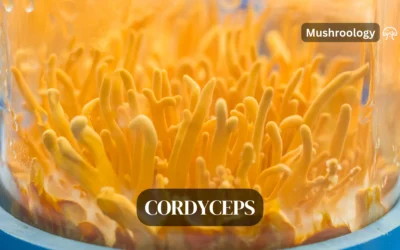The Pink Oyster Mushroom, scientifically known as Pleurotus djamor, is a tropical delight that stands out with its flamboyant pink hues and ruffled appearance. Native to subtropical and tropical regions, this mushroom is a visual treat and a culinary favourite for its meaty texture and delicate flavour.
What is Pink Oyster Mushroom?
- Domain: Eukaryota
- Kingdom: Fungi
- Division: Basidiomycota
- Class: Agaricomycetes
- Order: Agaricales
- Family: Pleurotaceae
- Genus: Pleurotus
- Species: P. djamor
Originally named Agaricus djamor by botanist Georg Eberhard Rumphius and later classified under the Pleurotus genus by Karel Bernard Boedijn in 1959, the Pink Oyster Mushroom has undergone various nomenclatural changes before arriving at its current scientific designation.
Pleurotus djamor is easily recognizable by its bright pink colour and curly cap, which ranges from 2 to 5 cm in diameter. The caps are notably thin, and the mushroom often lacks a distinct stem, contributing to its unique appearance. However, it’s important to note that the pink color fades when cooked.
Taste and texture of Pink Oyster Mushrooms
Described as having a meaty and slightly fishy flavor, Pink Oyster Mushrooms are rich in umami, making them a sought-after ingredient in various cuisines. Their texture is both meaty and chewy, and when fried until crispy, they can resemble bacon or ham. Raw, they may have a sour taste, adding to their versatility in cooking.
Why Choose Pink Oyster Mushrooms?
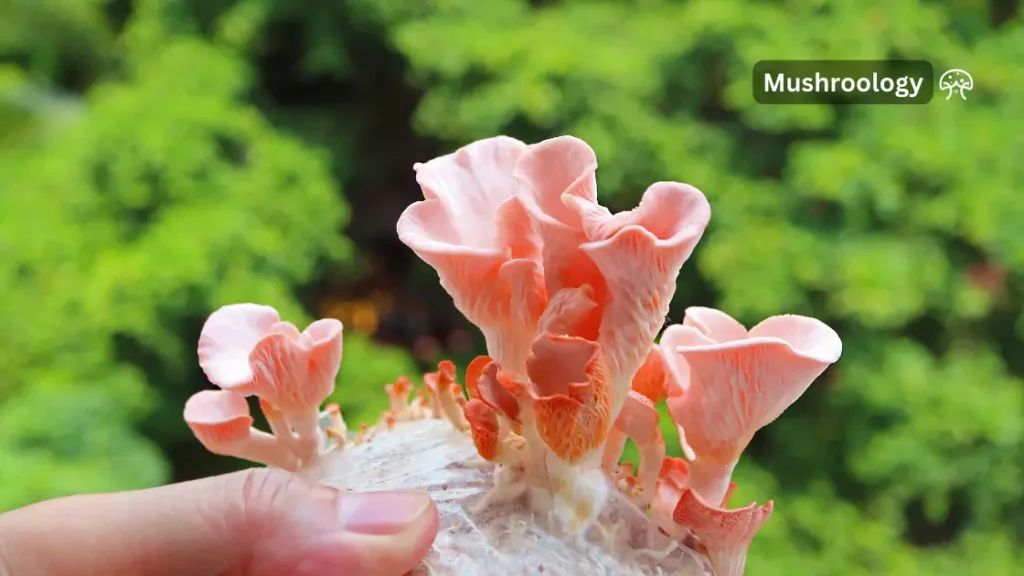
Pink oyster mushrooms are fast-growing, heat-tolerant, and prolific fruiters. They can thrive in less-than-perfect conditions and are particularly well-suited for warmer climates. Their unique color and flavor make them a favorite among home growers and chefs alike.
Materials needed to grow Pink Oyster Mushrooms
Before you start, gather the following materials:
- Substrate: Straw, hardwood sawdust, coffee grounds, or a mix (straw is highly recommended for beginners).
- Pink Oyster Mushroom Spawn: Grain spawn is preferred.
- Large Plastic Bag or Airtight Container: To maintain high humidity.
- Spray Bottle: For misting.
- Thermometer and Hygrometer: To monitor temperature and humidity.
- Clean Work Surface and Gloves: To maintain sterility and prevent contamination.
Step-by-Step growing process of Pink Oyster Mushrooms
1. Preparing the Substrate
The substrate is the material on which your mushrooms will grow. Here’s how to prepare it:
Choosing the Substrate
Pink oyster mushrooms are not picky eaters and can grow on a variety of substrates, including:
- Straw: One of the most commonly used substrates due to its accessibility and affordability. It allows for excellent water retention and air circulation.
- Hardwood Sawdust: Often used in combination with other materials like bran to provide additional nutrients.
- Coffee Grounds: An excellent substrate that is readily available and already pasteurized by the brewing process.
- Cardboard: Another viable option that is easy to source and prepare.
Pasteurizing the Substrate
Pasteurization is essential to eliminate any potential contaminants that could compete with the mushroom mycelium. Here are two common methods:
- Hot Water Pasteurization:
- Chop the straw into 3-5 inch pieces using a chopper, lawn mower, or string trimmer.
- Place the chopped straw in a pillowcase or mesh bag.
- Submerge the bag in hot water (65-80°C or 149-176°F) for 1-2 hours. Use a weight to keep the bag submerged.
- After pasteurization, drain the straw and let it cool to room temperature.
- Cold Water Lime Bath:
- Mix hydrated lime (about 12 grams per gallon of water) into cold water to create a high-pH solution.
- Soak the straw in this solution for 12-18 hours.
- Drain the straw thoroughly and let it reach room temperature before use.
Hydrating Sawdust Pellets
If using sawdust pellets:
- Soak the pellets in clean water for 30 minutes.
- Break up the pellets into a fine sawdust texture.
- Ensure the moisture content is optimal (50-70%) using the squeeze test: squeeze a handful of the substrate, and only a few drops of water should come out.
2. Inoculating the Substrate
Once your substrate is prepared and cooled, it’s time to inoculate it with pink oyster mushroom spawn:
Distribute the Spawn
Evenly distribute the spawn throughout the substrate using a clean, sterilized tool. For optimal results, use a ratio of 5-10% spawn to the wet weight of the substrate.
Mix Thoroughly
Ensure good contact between the spawn and substrate by mixing thoroughly. This helps the mycelium colonize the substrate more efficiently.
Sanitary Conditions
Work in a clean area with minimal traffic to prevent contamination. Wash your hands and sterilize your tools before starting the inoculation process.
Filling the Containers
Place the inoculated substrate into large plastic bags or airtight containers. If using bags, make sure to seal them properly to maintain high humidity levels.
3. Incubation
The incubation period is crucial for the mycelium to colonize the substrate fully. Here’s how to manage this stage:
Temperature and Humidity
Optimal Temperature: Keep the inoculated substrate at a consistent temperature between 20-30°C (68-86°F).
Humidity: Maintain high humidity levels, ideally around 85%.
Environment
Darkness: Place the bags or containers in a dark area to prevent early pinning or fruiting. Light exposure can trigger premature fruiting, which is not desirable during the incubation phase.
Ventilation: Ensure there is some airflow to prevent the buildup of CO2, but avoid direct exposure to drafts which can dry out the substrate.
Monitoring Progress
- Colonization Time: The mycelium will start colonizing the substrate, which can take 1-2 weeks. Pink oyster mycelium is fast-growing and may start pinning inside the bag within two weeks.
- Visual Check: The substrate should be fully covered in white, wool-like mycelium. This indicates that the mycelium has colonized the substrate and is ready for the next stage.
Common Pitfalls
- Contamination: Watch for signs of mold or other contaminants. If contamination occurs, it’s best to discard the affected substrate to prevent it from spreading.
- Temperature Fluctuations: Keep the temperature stable to avoid stressing the mycelium, which can slow down colonization or cause contamination issues.
4. Initiating Fruiting
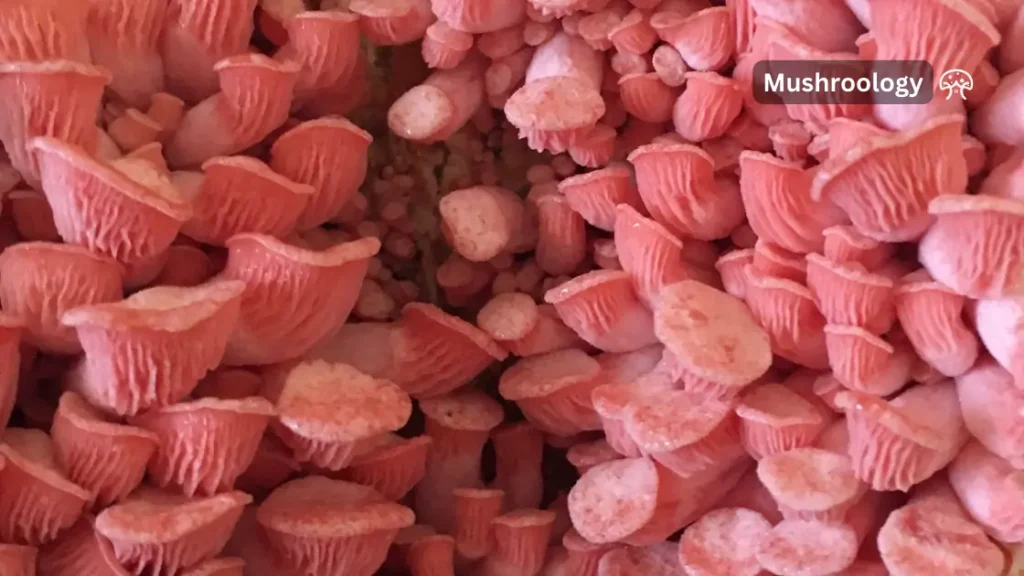
Once the substrate is fully colonized, it’s time to initiate fruiting:
- Cut Slits: Make small slits in the bag where the mushrooms are expected to fruit. This mimics natural conditions where mushrooms grow through cracks in tree bark.
- Humidity and Temperature: Maintain high humidity (80-90%) and a temperature range of 60-75°F (15-24°C).
- Light: Place the bag in an area with indirect light. Pink oyster mushrooms do not require direct sunlight but need some light to fruit.
5. Fruiting and Care
During the fruiting phase, it’s crucial to maintain optimal conditions:
- Misting: Mist the growing environment regularly with a spray bottle to keep humidity levels high.
- Ventilation: Ensure proper air circulation to prevent excess moisture buildup and reduce the risk of fungal diseases.
6. Harvesting your Pink Oyster Mushrooms
Pink oyster mushrooms grow quickly and can be ready for harvest within 1-2 weeks of initiating fruiting.
When to harvest Pink Oyster Mushrooms
Harvesting pink oyster mushrooms at the right time is essential to capture their peak flavor and texture. Here are the key indicators that your mushrooms are ready:
1. Cap Shape and Curling
One of the most reliable signs that pink oyster mushrooms are ready to be harvested is the shape of their caps. When the caps start to flatten out and the edges begin to curl upwards, it’s time to harvest. This indicates that the mushrooms have reached maturity and are about to drop their spores.
2. Color Changes
Pink oyster mushrooms are known for their vibrant pink color, which can fade as they mature. If you notice the mushrooms starting to lose their deep pink hue and turning a lighter shade, it’s a good time to harvest them. Waiting too long can result in the mushrooms becoming overly mature and losing their desirable texture.
3. Spore Load
Pink oyster mushrooms have a massive spore load, which can quickly cover your grow area with pink spores if not harvested in time. To avoid this, harvest the mushrooms before they start dropping spores. This is usually indicated by the caps curling up and the edges starting to thin out.
4. Texture and Firmness
Mature pink oyster mushrooms will have a firm texture and a full, savory flavor. If the mushrooms feel soft or mushy, they may be overripe. Harvesting them when they are firm ensures the best culinary experience.
How to Harvest Pink Oyster Mushrooms
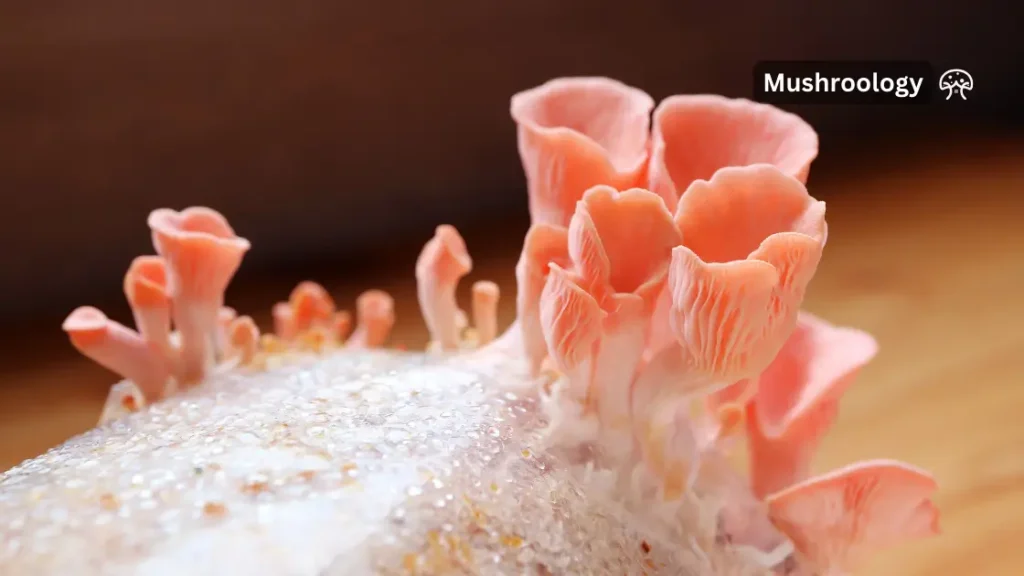
Once you’ve identified that your pink oyster mushrooms are ready for harvest, follow these steps to ensure a clean and efficient harvest:
Use a Sharp Knife: Cut the mushrooms off in whole clusters using a sharp knife. Avoid twisting or pulling the mushrooms, as this can damage the mycelium and create an opening for contamination.
Harvest in Clusters: Harvest the entire cluster of mushrooms at once rather than picking them individually. This helps protect the substrate for future flushes and ensures a clean harvest.
Handle with Care: Pink oyster mushrooms are delicate, so handle them gently to avoid bruising or damaging the mushrooms.
How to Harvest Pink Oyster Mushrooms
Once you’ve identified that your pink oyster mushrooms are ready for harvest, follow these steps to ensure a clean and efficient harvest:
- Use a Sharp Knife: Cut the mushrooms off in whole clusters using a sharp knife. Avoid twisting or pulling the mushrooms, as this can damage the mycelium and create an opening for contamination.
- Harvest in Clusters: Harvest the entire cluster of mushrooms at once rather than picking them individually. This helps protect the substrate for future flushes and ensures a clean harvest.
- Handle with Care: Pink oyster mushrooms are delicate, so handle them gently to avoid bruising or damaging the mushrooms.
Post-Harvest Care and Storage of Pink Oyster Mushrooms
Proper storage is essential to maintain the freshness and flavor of your pink oyster mushrooms. Here are some tips for storing them:
Refrigeration: Store the harvested mushrooms in a paper bag in the refrigerator. The paper bag helps absorb excess moisture and prevents the mushrooms from becoming soggy. Pink oyster mushrooms have a short shelf life and should be consumed within a few days of harvesting.
Freezing: If you can’t use the mushrooms immediately, you can freeze them. Separate the clusters into individual caps and store them in a plastic freezer bag. Frozen mushrooms can last up to a month, but be aware that freezing may affect their texture.
Dehydration: Dehydrating the mushrooms is another option for long-term storage. Use a food dehydrator or an oven set to a low temperature. Properly dehydrated mushrooms can last up to six months and can be rehydrated by soaking in water before use.
Can You Eat Pink Oyster Mushrooms Raw?
The short answer is that while you can eat pink oyster mushrooms raw, it is generally not recommended. Here are some reasons why:
1. Flavor and Texture
Raw pink oyster mushrooms have a sour taste and a chewy texture, which many people find unappealing. When cooked, their flavor transforms significantly, becoming more savory and similar to bacon or ham, which is much more enjoyable for most palates.
2. Digestibility
Cooking pink oyster mushrooms not only enhances their flavor but also makes them easier to digest. Raw mushrooms can be tough on the digestive system and may cause stomach discomfort for some individuals.
3. Potential Allergies
There is a potential risk of allergic reactions when consuming raw mushrooms. Some people may experience oral allergy symptoms or other reactions due to the presence of certain proteins and compounds in the raw mushrooms.
Expert Recommendations
Most experts and culinary guides recommend cooking pink oyster mushrooms to fully enjoy their taste and nutritional benefits. Cooking methods such as sautéing, frying, roasting, or boiling are commonly used to prepare these mushrooms.
How to Cook Pink Oyster Mushrooms
If you’re ready to cook your pink oyster mushrooms, here are some popular methods:
- Sautéing: Heat a pan over medium-high heat, add a bit of oil, and sauté the mushrooms until they are golden brown and crispy. This method brings out their savory, bacon-like flavor.
- Frying: Fry the mushrooms in a dry pan to let the water evaporate, then add butter, garlic, and a splash of lemon juice for a delicious treat.
- Roasting: Roast the mushrooms in the oven with a bit of olive oil and your favorite herbs for a crispy and flavorful side dish.
- Boiling: Add the mushrooms to soups or stews to enhance the overall flavor and texture of the dish.
Pink Oyster Mushroom Benefits
The Pink Oyster Mushroom is a visual and culinary treat and a powerhouse of nutrition and health benefits. This section explores these mushrooms’ nutritional content and their various health advantages.
Nutritional Content
Pink Oyster Mushrooms are low in calories and fat, making them an excellent choice for those looking to maintain or lose weight. A one-cup serving (approximately 86 grams) of raw oyster mushrooms contains:
- Calories: 28
- Carbohydrates: 5 grams
- Protein: 3 grams
- Fat: Less than 1 gram
- Fiber: 2 grams
- Niacin (Vitamin B3): 27% of the Daily Value (DV)
- Pantothenic Acid (Vitamin B5): 22% of the DV
- Folate: 8% of the DV
- Choline: 8% of the DV
- Potassium: 8% of the DV
- Iron: 6% of the DV
- Phosphorus: 8% of the DV
- Zinc: 6% of the DV
Additionally, they contain smaller amounts of other nutrients, including vitamin D and selenium, and are a good source of riboflavin, vitamin B6, magnesium, and vitamin C.
Pink Oyster Mushroom Benefits
Antioxidant Properties
Pink Oyster Mushrooms are rich in antioxidants like phenolic compounds, which include gallic acid, chlorogenic acid, and naringenin. These substances help reduce cellular damage in the body. The amino acid ergothioneine, found in these mushrooms, has powerful antioxidant effects that may protect against oxidative stress and cellular damage.
Heart Health
Consuming Pink Oyster Mushrooms may support heart health by reducing risk factors such as high cholesterol and high blood pressure. They are particularly high in beta-glucans, fibers that can help reduce cholesterol production in the liver. Beta-glucans are also fermented by gut bacteria to produce short-chain fatty acids that contribute to cholesterol reduction.
Immune System Support
The beta-glucans in Pink Oyster Mushrooms are known for their immune-modulating properties. They help balance the immune system, neither overstimulating nor suppressing it, which is crucial for maintaining a healthy immune response.
Anti-Inflammatory Effects
These mushrooms contain anti-inflammatory compounds that may reduce inflammation throughout the body. This can be particularly beneficial in preventing chronic diseases associated with systemic inflammation, such as dementia and heart disease.
Anti-Cancer Properties
Some studies suggest that Pink Oyster Mushrooms may have anti-tumor properties. While more research is needed, particularly in humans, the potential for these mushrooms to inhibit the growth of cancer cells is an area of significant interest.
Blood Sugar Regulation
Oyster Mushrooms may help regulate blood sugar levels, which is beneficial for individuals with diabetes or those looking to maintain stable blood sugar. They have been shown to lower fasting blood sugar levels in some studies.
Bone Health
With their content of vitamin D and magnesium, Pink Oyster Mushrooms contribute to building strong bones. These nutrients are essential for calcium absorption and storage in the bones.
Gut Health
Supplementing diets with oyster mushrooms has been shown to decrease the growth of pathogenic bacteria in the gut, promoting a healthy gut microbiome.
Packed with protein, fiber, and a range of vitamins and minerals, Pink Oyster Mushrooms are a nutritious addition to any diet. They are known for their potential cholesterol-lowering effects and are a great meat substitute for vegetarian and vegan diets.
Culinary Uses of Pleurotus djamor
Pink Oyster Mushrooms, known for their striking appearance and unique flavor profile, offer a world of culinary possibilities. From simple sautés to complex dishes, these mushrooms can elevate any meal.

The Pink Oyster Mushroom is a fascinating species offering visual appeal and culinary versatility. Whether you’re a gourmet chef, a home cook, or a mushroom cultivator, Pleurotus djamor is a species that can add both beauty and taste to your endeavors.
Remember, the key to enjoying these mushrooms is to use them fresh and to experiment with different recipes that highlight their unique flavor and texture. Happy foraging and cooking!

